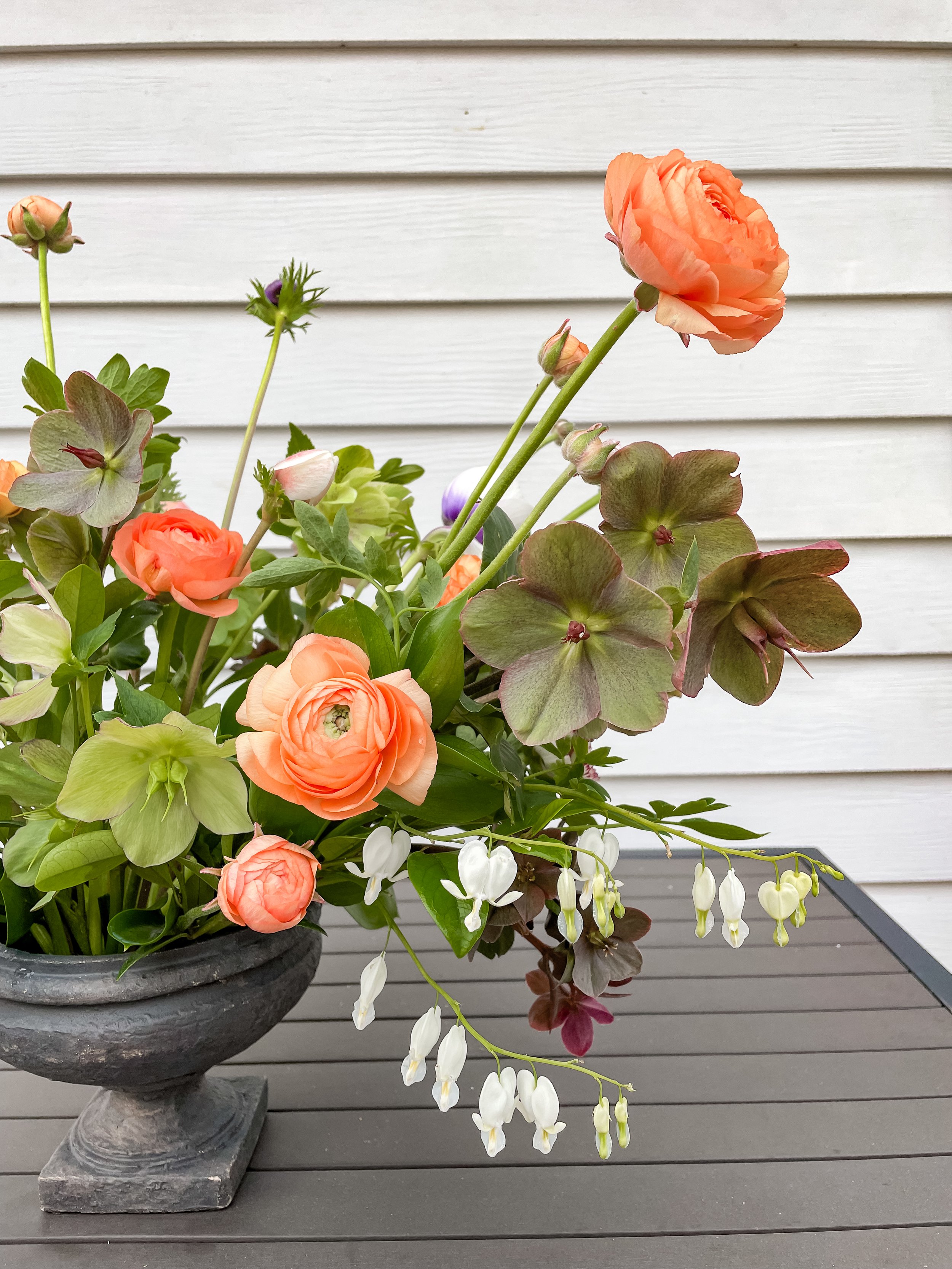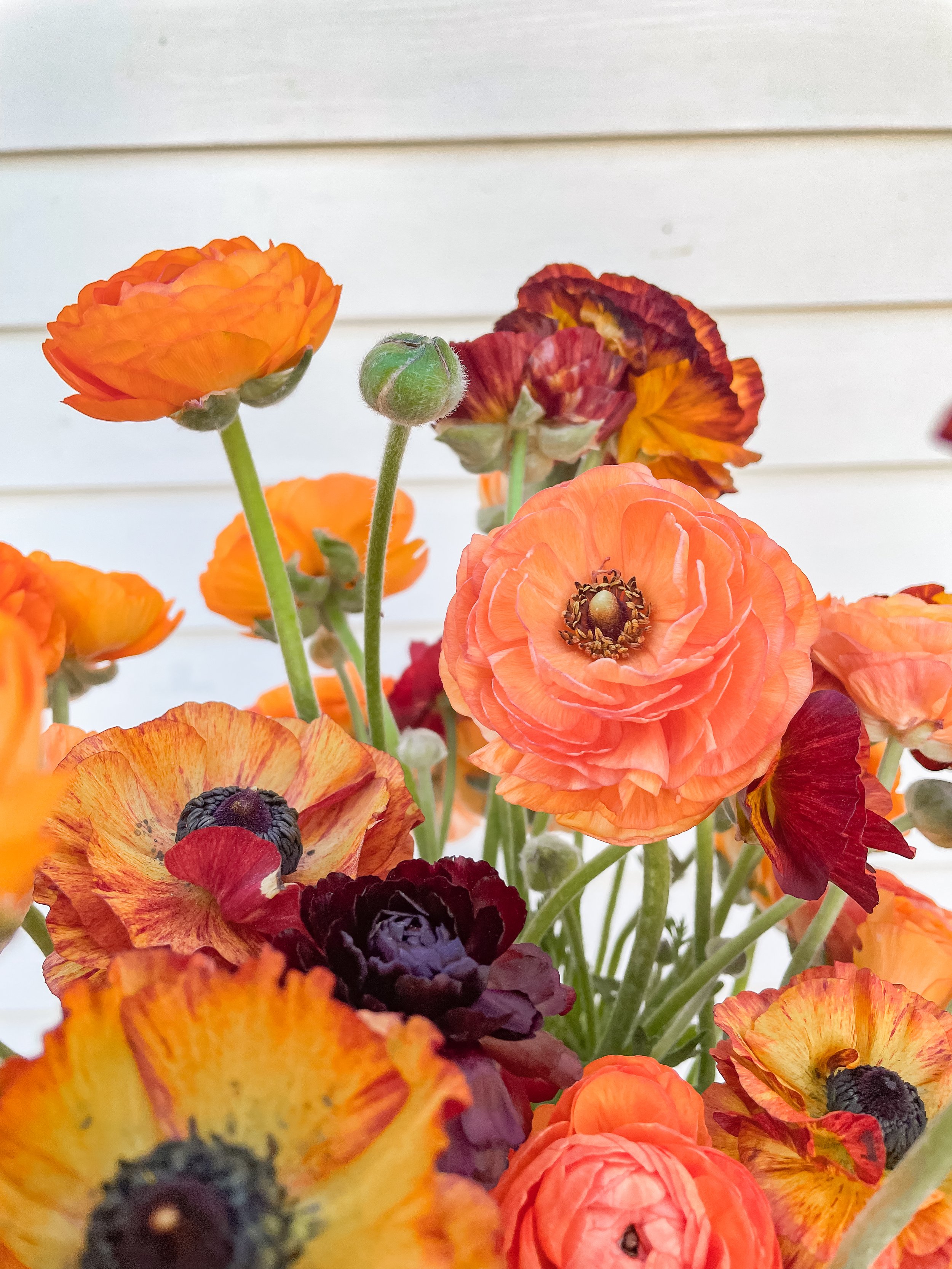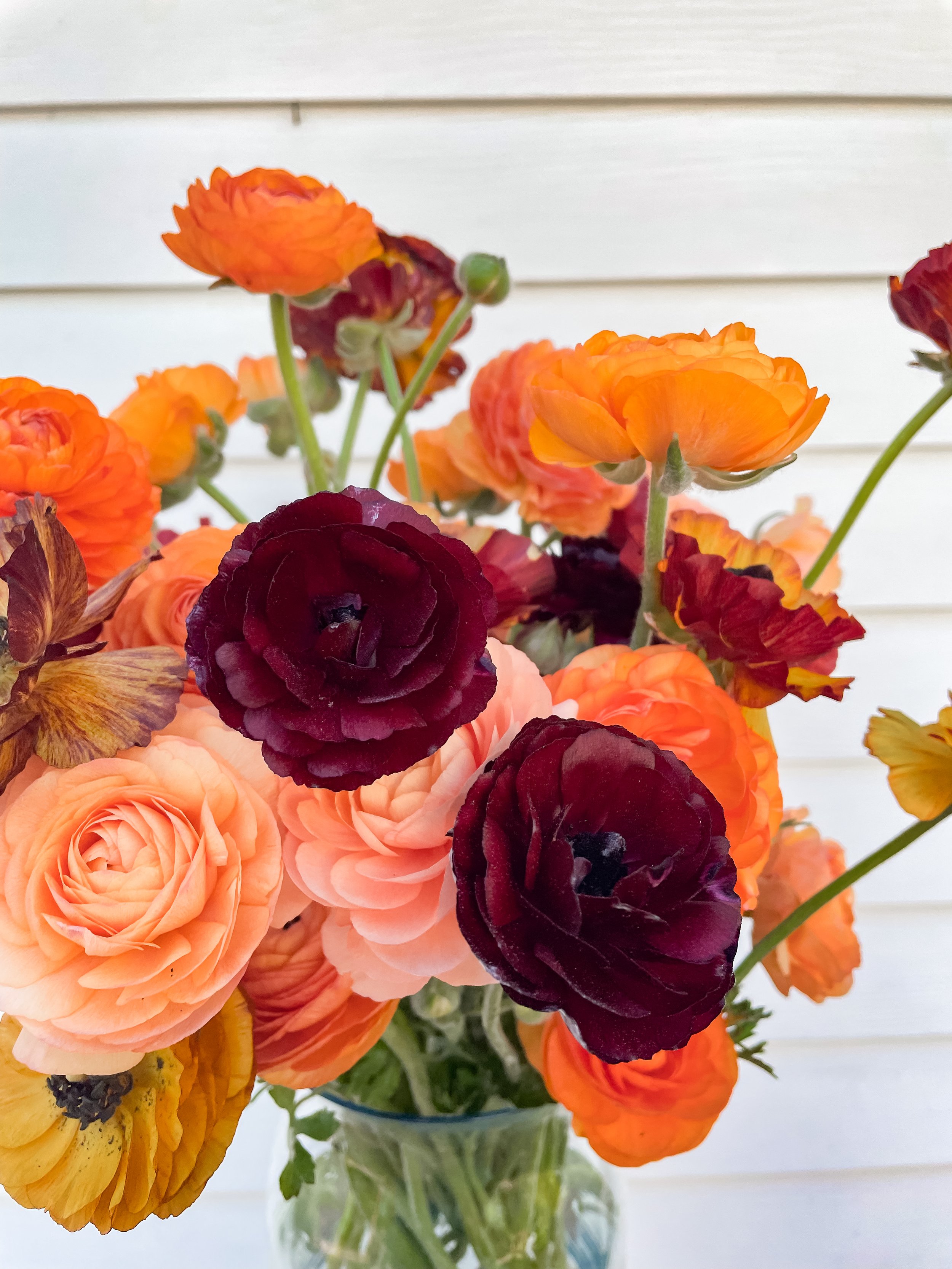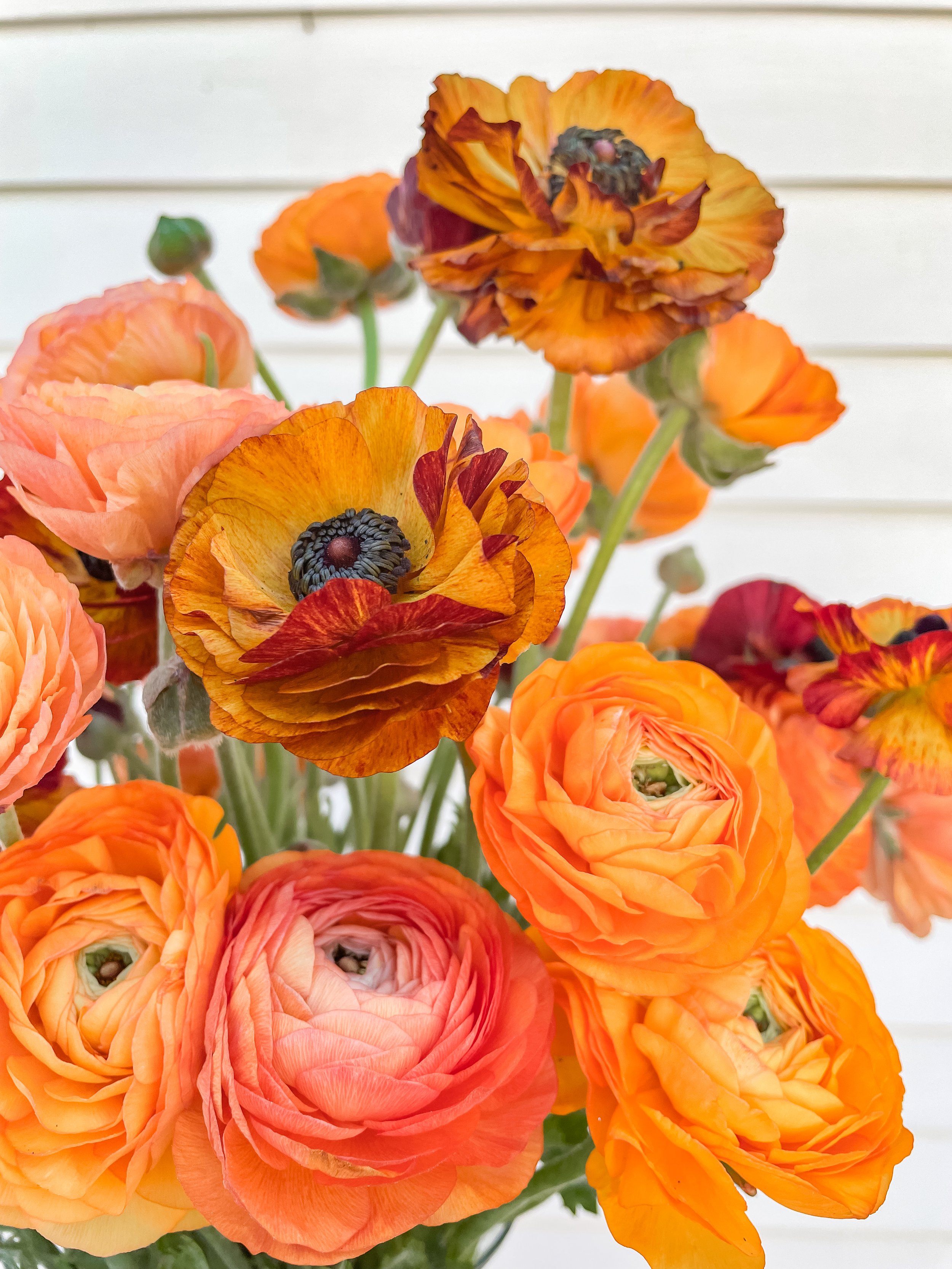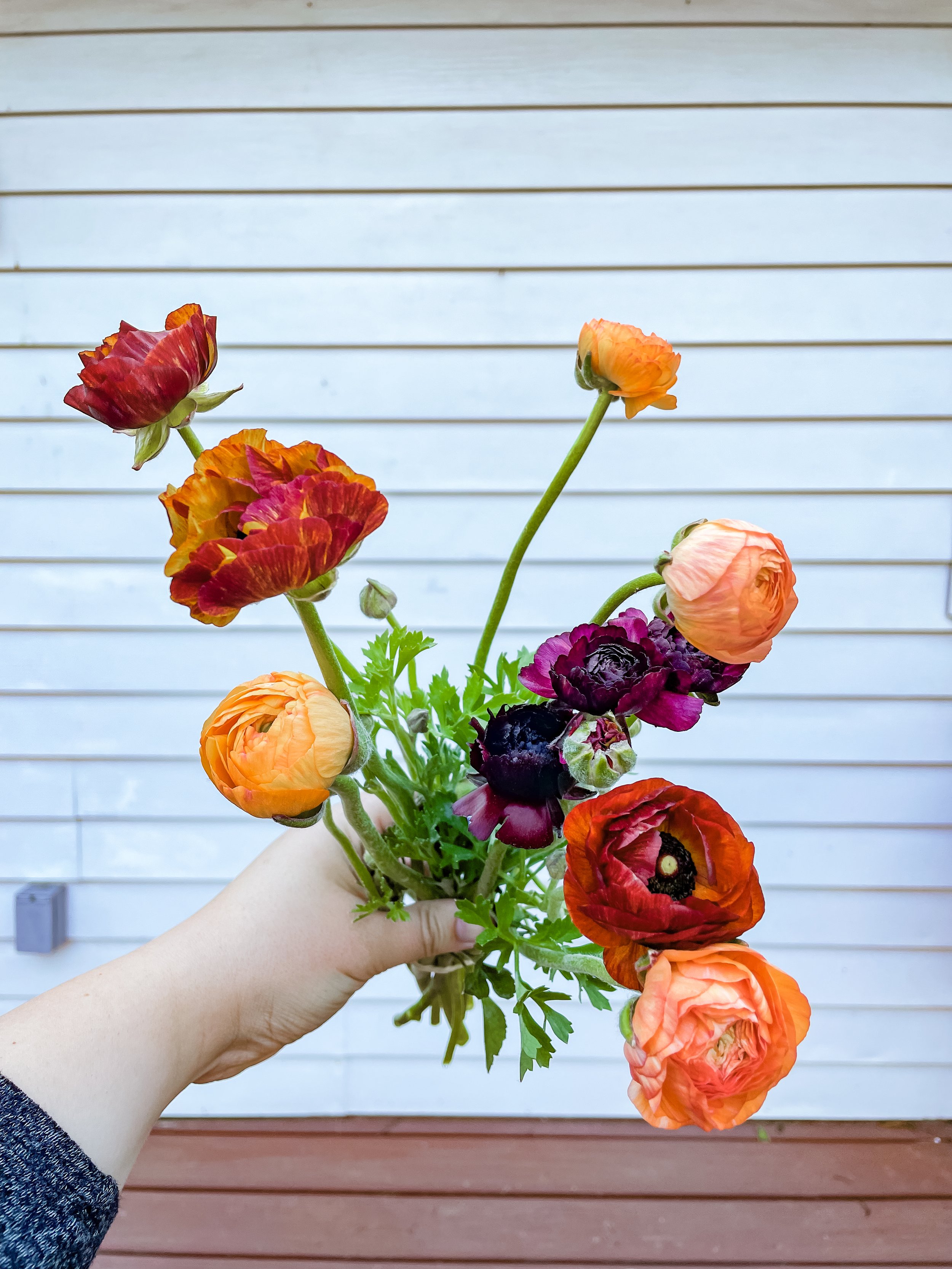How I Grow Ranunculus
getting these cool-weather flowers to thrive in a very warm state
Since before I knew their name, I have loved ranunculus. These delicate, many-petaled beauties come in a rainbow of soft shades, and they appear in grocery stores as a harbinger of spring.
As with many of spring’s earliest bloomers, ranunculus are stunning by themselves, but they play nice with just about everything. So naturally, when we started planning for our garden, I wanted to grow them for myself. In fact, they were the flower I most wanted to grow.
What I didn’t know is that they aren’t particularly well-suited to warm climates like ours in Alabama. (I am in Zone 7; find your zone here.) Once temperatures regularly get above 75ºF, ranunculus flower production slows to a halt, but they’re also known to be sensitive to deep cold snaps.
Here, temperatures start rising in late April. Since it takes ranunculus about 90 days to bloom, that would mean planting in January, which tends to be our truly cold month, the most likely time for deep freezes.
Because of these climate-related issues, a few local hobbyist growers warned me away from growing ranunculus; they said it wasn’t worth the effort. This is a valid position: one zone warmer, and the plants would happily make it through a mostly frost-free winter; one zone cooler, and they would have more time to bloom before warm temperatures and could be planted in early spring. Our zone is a tricky one!
But still, I ignored them, and I’ve had some wild success. Ultimately, it’s fairly simple: start early, and baby them through the cold months. Most resources online are directed toward flower farmers, so I want to share what I’ve learned as a hobbyist, a backyard flower-grower with a day job and supplies purchased from the hardware store.
How to Grow Ranunculus in Zone 7
Here’s a month-by-month guide; if you’re a visual learner, skip to the end for an Instagram reel of the process!
Late October:
I soak my dry corms for 2 hours under trickling water; the slight drip of water keeps the oxygen levels higher. After soaking, the corms are plump, and I drain the water.
I immediately spread the corms in a tray with dampened seed starting mix. lightly covering them. They don’t need any light at this point, just a cool area and enough moisture to get going. After about a week like this, the corms will have developed little white roots, and it’s likely that some of them will have sprouted. The process is called pre-sprouting, and it wakes up the corms and also makes them unpalatable to rodents.
Early November:
In a garden bed prepared with fresh compost, I plant the corms about 6 - 9 inches apart, “tentacles” down. Any foliage that has emerged goes above the soil line. Over the next few weeks, small parsley-like plants will grow. From here, they’re very low maintenance through winter.
December - February:
The primary challenge in these months is protecting the small plants from deep frosts. I read that ranunculus are cold-sensitive, so the first year I grew them I ran out any time the temperatures were predicted to hit 32ºF at night. But I’ve since found that they’re a little more robust than that.
My current practice is to cover them when our temperatures are expected to be around 25ºF for an extended period of time. So if it’s a light nighttime frost, I don’t worry about them. But if daytime temperatures will be below freezing, I make sure they’re covered. (More on this below.)
March - April:
As soon as temperatures warm into the upper 40ºs, the plants seem to wake up and put on more growth. As soon as I notice more foliage coming in (late February-ish), I begin to fertilize every other week or so (I use this fertilizer).
Expect 6-8 weeks of bloom time from your plants. I usually get blooms starting in mid-March, and the plants will bloom until temperatures regularly get above 75º in the day time, which is generally late April here. They slowly taper off, producing fewer and fewer blooms. My blooms tend to get smaller as the plants are spent.
May - June:
After the plants are done producing, the foliage will die back. I don’t pull them out before this happens; the plant is storing food for next year’s blooms! Once they’re looking pretty sad, I dig the corms up and cut off any remaining foliage. Corms may have doubled or tripled in size since I planted them, so I break them apart now, and get very happy that I’ve just made some new corms! I give them a good rinse, set them in a cool, dry area to fully dry, and store them away somewhere dry and dark until fall.
Since I have small quantities, I usually store them in an un-zippped sandwich baggie in a shoe box in our workshop area. I mark each bag with the variety name.
Common Problems with Ranunculus:
I want to offer some more in-depth trouble shooting with some issues I’ve had in the last few growing seasons. If you have any additional questions, drop them in the comments and I’ll try to help!
Rabbits love ranunculus foliage. I’ve made low hoops by bending 1/2” EMT conduit, and I drape them with bird net to keep the rabbits from getting to the sprouted foliage. (Here is a great tutorial for making hoops like ours.) I keep the net on through the entire growing process. Our rabbits are relentless, and foliage loss really sets the plants back. To be honest, I find the net annoying - it makes weeding, fertilizing, pest management, and cutting more challenging. But it’s been incredibly successful in protecting the plants. This spray is also very effective, but I have a hard time staying on top of it. Rabbit fences have done nothing for us, and I’ve watched them hop over 42” fencing and (somehow!) through the 4” squares at the top. There is no more motivated snacker than a rabbit.
Rodents will dig up ranunculus corms once they’re spent/before they’re sprouted. Just like nuts and bulbs, corms are nutrient-rich, and rodents love them. The first year I grew, I compared fall planting pre-sprouted corms and spring planting corms in the ground after soaking. None of the ones that immediately went in the ground made it; the animals got them all. Pre-sprouting solved this problem for me, and squirrels and chipmunks also can’t get through the bird net I use over our hoops. Of the pests, these are the easiest to deal with!
Protecting ranunculus from the cold: I realized after my first year of growing that running out with frost cloth “as needed” is a pain. Last year we were hit with unusually cold back-to-back deep freezes, and in anticipation I ordered Agribon AG-19. I clamped it over our hoops (and the net) to keep it in place, and I ended up leaving it on through March, mostly out of laziness. My initial concern was that a lack of light would stunt the plants, but AG-19 lets 85% of light in, and they did great in these DIY low tunnels. As soon as we were past freezing temperatures, I took the frost cloth off and left the bird net on. This year, I’m going to cover our hoops with frost cloth as soon as we get to our coldest months.
My Favorite Varieties of Ranunculus:
I’ve never met a ranunculus that I didn’t like, but I have a few special favorites. The thing to know about ranunculus "varieties” is that there can be a lot of variation in each one. Typically, corms will come in a little bag of 10-20, and it’s a surprise when they bloom. Each corm will produce a consistent color, but the mix will vary. I’m sure each farm also has a slightly different blend.
I’m going to try to describe the varieties and my experience with them!
(A note: I am linking to Eden Brothers because they leave their varieties up year-round, so it’s a great reference tool. I’ve purchased from several smaller farmers, but their shops come on and offline as they make their corms available. Links to those are in the next section.)
If I had to choose just one variety to grow, I would choose “Porcelaine.” The blooms are large and the softest pinks you can imagine; the edges of the petals are slightly lighter than the rest of the flower. My mix had a few huge, fluffy white corms as well. I sold a few bunches of these to local florists, and they made for some incredible bridal bouquets!
The most dramatic ranunculus in my patch is “Black.” This variety has remarkable color consistency: an almost unworldly deep red, absolutely impossible to capture in a photo but so magical in person. The blooms are on the smaller side.
For a vintage feel, you can’t beat the “Cafe” mix. This variety is a popular choice with florists for fall weddings: it’s full of more muted oranges, reds, and yellows. This variety also has some unique forms: many of the blooms have fewer petals and will open fully to reveal a black center, almost like poppies. Cafe doesn’t seem to have quite as long of a vase life as other varieties, I assume because there are fewer petals.
For a little bit of dip-dyed fun, you can’t beat “White Picotee.” These blooms are fairly consistent - white petals with ruffly magenta edges. If I was dropping one variety from my lineup, it would be this one; they’re fun, but my palette is more peachy, and these don’t blend as well. If you prefer a more berry palette, you’ll love these.
If you (like me) love the peachy-orange-pink world, head for “Salmon” or “Champagne”. These two varieties have a lot of overlap. I think maybe there’s a bit more yellow in the Champagne variety and a bit more pink in the Salmon, but that may have just been what I got, because I’ve seen the reverse in some photos! Both are primarily orangey-peach.
A few varieties that I’m planning to try in the future: “Violet,” which I’ve received in a gift arrangement and found just as mesmerizing as Black, but more purple than red; and “Chocolate,” which seems like it has very consistent and unique coloring but a fun variety in the form of the blooms.
Where to Buy Ranunculus Corms:
I always try to support American farms when I can, and there are so many great options. I usually expect to pay a little bit more than $1/corm, though that can vary based on variety and seller. Here are a few sellers to consider:
Sunny Meadows Flower Farm (Ohio): They have a smaller selection, but most of the most common varieties as well as a few unique mixes.
The Flower Hat (Montana): TFH has a record of crazy-competitive shop openings, but it’s worth it for the large, healthy corms and some unique varieties, like butterfly ranunculus, which I’m still trying to get my hands on!
EasytoGrow on Etsy (California): I haven’t used this seller before, but they have great reviews, and I’ve noticed that they have stock year-round, whereas many other sellers only have corms stocked in the fall and sell out quickly.
Eden Brothers: this company is a mega-player in the seed/bulb/corm/tuber game. I’ve ordered many times with good results. The corms I’ve received from the smaller farms have been larger, but I haven’t noticed any difference in flower production.
How to Grow Ranunculus in 1 Minute:
For Further Reading:
Longfield Gardens | 10 Tips for Growing Ranunculus
Floret Flowers | How to Grow Ranunculus
Loven Fresh | Ranunculus and Anemones in Zone 6b/7
This post includes affiliate links. Click here to learn more.
